For the past year or so I've been building dipole and cardioid horns. Personally, I think there's a lot to like:
1) They're much easier to build. No need to hassle with sealing off your midranges. It also allows for a much larger selection of mids.
2) To my ears, they seem to reveal things in the music that sealed back drivers do not. I am still trying to figure out why this is, and I'll speculate on that later in the thread.
3) They image better. This effect is unmistakable; the speaker simply "disappears" better when it is a dipole or a cardioid. You can test this in a matter of seconds, by sealing off the driver. And when you do that, the stereo image goes from a big airy space to a very small size, and it's constrained to the speaker location.
4) Probably my favorite thing about dipole and cardioid horns is that they add a measure of "ambience" to the system. For instance, my most successful Unity horn project measured and sounded good, but listening to it was always like listening to a giant set of headphones. Going dipole or cardioid reminds me a little of the ambiophonic processing, where the whole soundstage just becomes a lot bigger. Clearly, this is a measure of personal taste, and some will prefer the "giant headphone" type of presentation.
I am currently working on a couple of projects. The first is a set of Synergy horns for the home, using dipole midranges. It is documented in the thread named "Monster Massive." The second is a set of Synergy horns for my Mazda6, with cardioid midranges, documented in my thread named "Edge of No Control."
I wanted to create a seperate thread for the data on the cardioids and dipoles, because the information will have a wider appeal than my build threads. And also because there is very very little information on DIY cardoids. There was a website exploring DIY cardioids, which was quite an inspiration, but the site is gone now.
1) They're much easier to build. No need to hassle with sealing off your midranges. It also allows for a much larger selection of mids.
2) To my ears, they seem to reveal things in the music that sealed back drivers do not. I am still trying to figure out why this is, and I'll speculate on that later in the thread.
3) They image better. This effect is unmistakable; the speaker simply "disappears" better when it is a dipole or a cardioid. You can test this in a matter of seconds, by sealing off the driver. And when you do that, the stereo image goes from a big airy space to a very small size, and it's constrained to the speaker location.
4) Probably my favorite thing about dipole and cardioid horns is that they add a measure of "ambience" to the system. For instance, my most successful Unity horn project measured and sounded good, but listening to it was always like listening to a giant set of headphones. Going dipole or cardioid reminds me a little of the ambiophonic processing, where the whole soundstage just becomes a lot bigger. Clearly, this is a measure of personal taste, and some will prefer the "giant headphone" type of presentation.
I am currently working on a couple of projects. The first is a set of Synergy horns for the home, using dipole midranges. It is documented in the thread named "Monster Massive." The second is a set of Synergy horns for my Mazda6, with cardioid midranges, documented in my thread named "Edge of No Control."
I wanted to create a seperate thread for the data on the cardioids and dipoles, because the information will have a wider appeal than my build threads. And also because there is very very little information on DIY cardoids. There was a website exploring DIY cardioids, which was quite an inspiration, but the site is gone now.
We all hear things differently
In other words, I respectfully disagree. To wit:
I auditioned a large format midrange horn using what many consider one of the best 17cm drivers available, fitted to the horn, but with no back chamber at all, and it was absolutely horrid.
In my own systems, in my very well known listening area, everytime I have tried an "open back" it sounds dreadful. That darned back wave splashing all over wreaking havoc on the soundstage perserved in the recording to begin with. I then placed a cardboard tube behind the driver and stuffed it with acoustic absorbent, and all things fell into place rather nicely.
PLEASE UNDERSTAND: I am not saying that I am right and you are wrong.
What I am saying is, that what I have learned : each of us have some sort of "aural image" fixed in our minds as to what is "right sounding" and the means to reach this "nirvana" varies immensly among us.
In other words, I respectfully disagree. To wit:
I auditioned a large format midrange horn using what many consider one of the best 17cm drivers available, fitted to the horn, but with no back chamber at all, and it was absolutely horrid.
In my own systems, in my very well known listening area, everytime I have tried an "open back" it sounds dreadful. That darned back wave splashing all over wreaking havoc on the soundstage perserved in the recording to begin with. I then placed a cardboard tube behind the driver and stuffed it with acoustic absorbent, and all things fell into place rather nicely.
PLEASE UNDERSTAND: I am not saying that I am right and you are wrong.
What I am saying is, that what I have learned : each of us have some sort of "aural image" fixed in our minds as to what is "right sounding" and the means to reach this "nirvana" varies immensly among us.
I'll post some data, but here's some things that I've noticed:
1) There's barely any documentation on cardioid and dipole midrange horns at all. The pro guys do tons of stuff with them for bass, but for midrange? This is not common.
2) John K and Siegfried Linkwitz have been invaluable in documenting dipoles. Unfortunately, the rules change quite a bit when you horn load the drivers. This can actually be a good thing though; dipoles have issues with excursion, and a horn lowers it.
3) By far, the main thing that I'm noticing is that their bandwidth is narrow. So you get this really nice frequency response, polar response, and distortion level, but it's only good for an octave or two. For instance, I can squeeze about two to two and half octaves out of a sealed back midrange on a horn. With an open back it's about one octave. This is similar to the situation with tapped horns, where you can reduce the horn size but the bandwidth is narrower due to peaks and dips above the passband.
1) There's barely any documentation on cardioid and dipole midrange horns at all. The pro guys do tons of stuff with them for bass, but for midrange? This is not common.
2) John K and Siegfried Linkwitz have been invaluable in documenting dipoles. Unfortunately, the rules change quite a bit when you horn load the drivers. This can actually be a good thing though; dipoles have issues with excursion, and a horn lowers it.
3) By far, the main thing that I'm noticing is that their bandwidth is narrow. So you get this really nice frequency response, polar response, and distortion level, but it's only good for an octave or two. For instance, I can squeeze about two to two and half octaves out of a sealed back midrange on a horn. With an open back it's about one octave. This is similar to the situation with tapped horns, where you can reduce the horn size but the bandwidth is narrower due to peaks and dips above the passband.
For the past year or so I've been building dipole and cardioid horns. Personally, I think there's a lot to like:
1) They're much easier to build. No need to hassle with sealing off your midranges. It also allows for a much larger selection of mids.
2) To my ears, they seem to reveal things in the music that sealed back drivers do not. I am still trying to figure out why this is, and I'll speculate on that later in the thread.
3) They image better. This effect is unmistakable; the speaker simply "disappears" better when it is a dipole or a cardioid. You can test this in a matter of seconds, by sealing off the driver. And when you do that, the stereo image goes from a big airy space to a very small size, and it's constrained to the speaker location.
4) Probably my favorite thing about dipole and cardioid horns is that they add a measure of "ambience" to the system. For instance, my most successful Unity horn project measured and sounded good, but listening to it was always like listening to a giant set of headphones. Going dipole or cardioid reminds me a little of the ambiophonic processing, where the whole soundstage just becomes a lot bigger. Clearly, this is a measure of personal taste, and some will prefer the "giant headphone" type of presentation.
I am currently working on a couple of projects. The first is a set of Synergy horns for the home, using dipole midranges. It is documented in the thread named "Monster Massive." The second is a set of Synergy horns for my Mazda6, with cardioid midranges, documented in my thread named "Edge of No Control."
I wanted to create a seperate thread for the data on the cardioids and dipoles, because the information will have a wider appeal than my build threads. And also because there is very very little information on DIY cardoids. There was a website exploring DIY cardioids, which was quite an inspiration, but the site is gone now.
What was (is?) the outcome of the Monster Massove project? http://www.diyaudio.com/forums/multi-way/244508-monster-massive-12.html
What was (is?) the outcome of the Monster Massove project? http://www.diyaudio.com/forums/multi-way/244508-monster-massive-12.html
Still in progress.
I've toyed with the idea of taking the waveguides that I made for my car, the ones used in the Econowave, and using them in the house. That project sounds *really* good. Maybe as good as anything I've ever heard in a car. But they're BIG. Maybe too big for the car. (That project is documented in the "Edge of No Control" thread.)
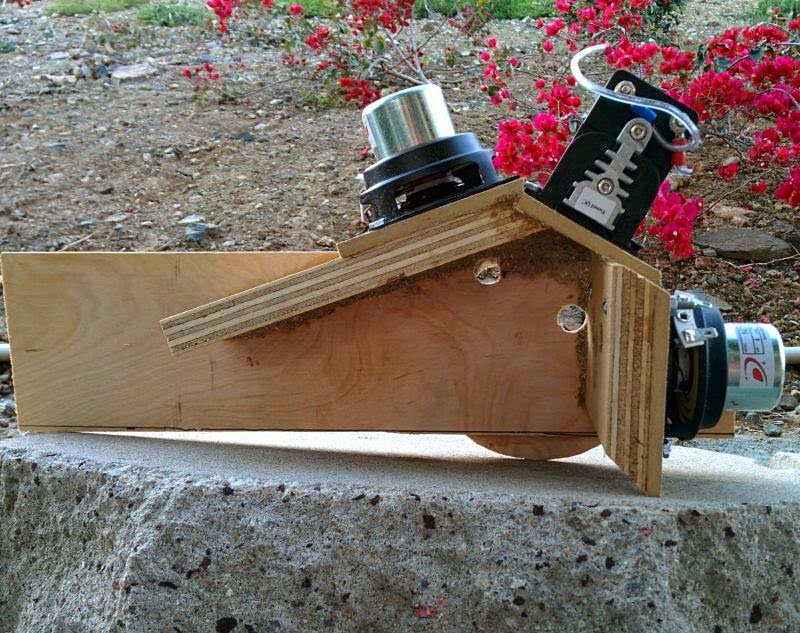

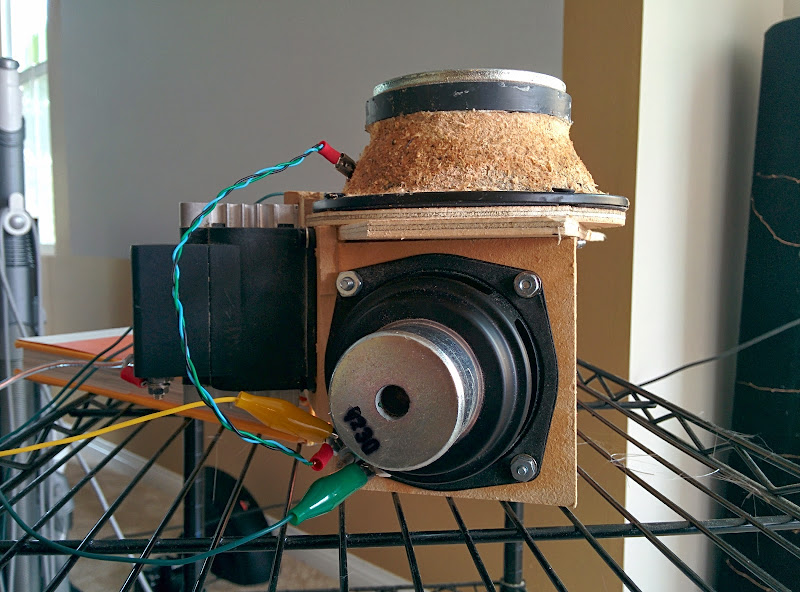
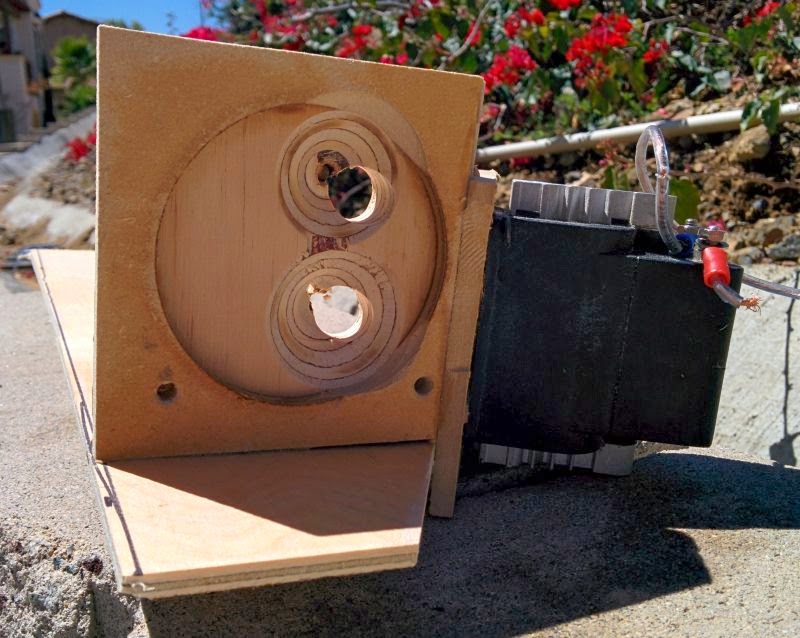
As usual, most of my weird stuff is for the car, but I post here because this is where guys like Danley, Geddes and Kreskovsky post.
The body of the horn is extraordinarily small. Basically the idea is to use the horn to control the directivity of the tweeter, and from 1khz down, it's cardioid. (Or at least that's the goal!)
In my 'Monster Massive' project I experimented with using fiberglass damping to get a cardioid response. But nowadays, I think a combination of sealed and dipole is a more consistent solution.
So here's the idea:
1) There's a ribbon at the apex, and it's loaded by the horn. The width of the horn provides directivity down to about 1khz.
2) The vertical directivity is mostly dictated by the height of the ribbon. Due to it's 2.5" height, it is very directional above 4khz. A taller ribbon would be directional down to a lower frequency, but it probably wouldn't reach 20khz. An array of ribbons might.
3) The sealed driver does the same thing that it does on any Unity, Synergy or front loaded horn. Due to the very small size, there's very little directivity control for the sealed driver. On the upside, the dash and door of the car constrain the vertical and horizontal directivity.
4) When you combine a dipole with a sealed driver, you get a cardioid. This is because the out-of-phase output from the dipole reduces the amount of low frequencies radiated backwards. For instance, a 4" dipole will have nulls to the sides beginning around 3khz, and the cancellation will get deeper as the frequencies get lower. Combine those cancellations with a sealed box, and you get a forward lobe that's stronger than the energy radiated to the back, left, and right.
Something happened to me last week, that's only happened one other time with a car stereo. I was listening to first few seconds of a track, and I thought that it was a cover, or a re-recording. Basically, the track sounded so different than what I was accustomed to, I thought it was a different recording. IE, my brain immediately registered what the song was, but the sound was so different, I experienced cognitive dissonance, thinking it couldn't be the song I knew so well.
That's a really tantalizing thing. It's one thing to have a speaker that sounds a little smoother or a speaker that plays a little louder. I think a big part of the audiophile hobby is just changing your gear, not necessarily improving your gear. (IE, we all know guys that swap gear out endlessly, mostly because they like the novelty of a new toy. For those guys, it doesn't have to be better it just has to be different.)
The first time I experienced that in a car was in Jon Whitledge's Magic Bus. My car doesn't sound in ANY way like the Bus, but I *did* experience that effect last week.
The thing that really stood out about Jon's bus is the bass. In car audio, it is incredibly easy to generate a lot of bass. But this is a double edged sword. The reason that it's so easy to generate bass in a car is because the environment is tiny. The tiny environment means there's a ton of early reflections. These early reflections increase the quantity of the bass, but they also make the bass sound plodding and slow. You can easily see this in an impulse response measurement; there's a huge amount of early reflections in a car.
Jon's obsessed about dealing with those reflections, and a big part of the reason that his car stereo is in a bus is to make room for the helmholtz absorbers that 'soak up' all that reflected energy.
The results are remarkable. It's difficult to describe how good the bass is, because most people simply haven't experienced a subwoofer and room that's engineered to these kinds of standards. In Jon's bus, it's not just about a lot of clean output; it's the impulse response that's so remarkable. The bass notes hit, and then decay into a noise floor that's completely black. It's almost like you're not listening in a room or a car; it's like the walls just aren't there.
IMHO, dipoles and cardioids may hold similar promise. I'm not nuts, I'm not going to go out on a limb and say this is the "end all / be all." But I think it holds a lot of promise. When you think about it, a dipole or cardioid does something similar to what the helmholtz absorbers do. An absorber 'soaks up' bass, and is tuned to a specific frequency. Basically the sound wave hits the absorber, and a fraction of the sound gets swallowed up. This helps anchor the bass to the speakers, because your ears are hearing less of the reflected energy.
A dipole or a cardioid has the potential to do something similar. But instead of the sound being absorbed by room treatment, the sound is destroyed at the source.
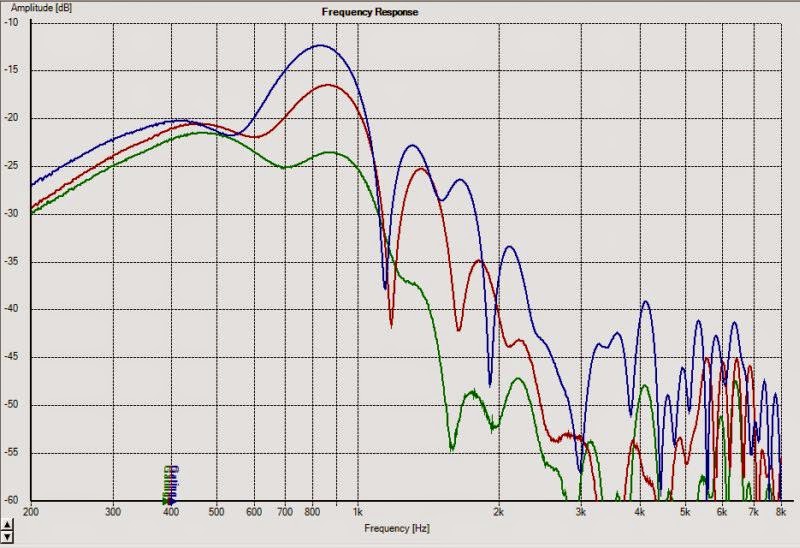
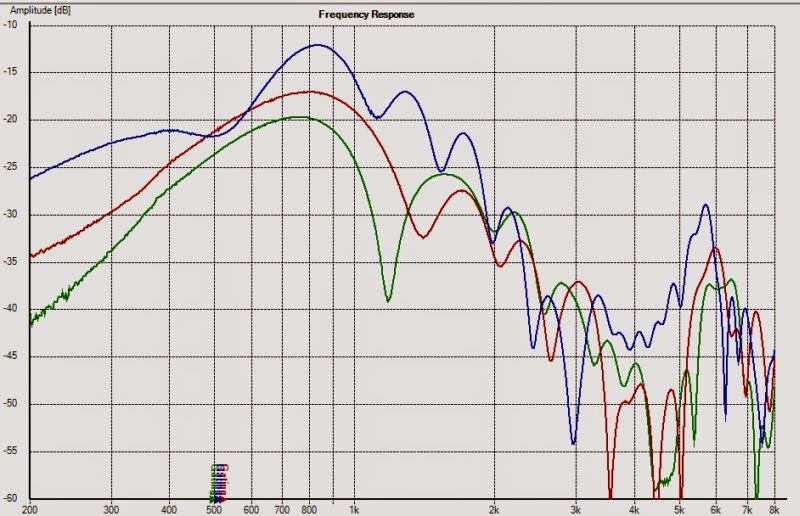
Here's two measurements. The first measurement is of the sealed driver alone, a Pyle PDMR5. The second measurement is of the cardioid array, which creates a cardioid by combining two Dayton ND91 dipoles with the Pyle sealed driver.
Above 600hz, both configurations are "hotter" on-axis than off. But below 600hz, the monopole horn goes omnidirectional. Even if you're standing behind the speaker, the SPL level doesn't fall. In a room, this is a problem; it means that the radiation will hit the back wall, top wall, etc. And get reflected back 'into the mix.'
I think that behavior is part of the reason that the cardioid in the car sounded so great. In a room, we have the luxury of pulling the speakers away from a wall. But in a car? Not so much. At 500hz, the sound of a midrange in a car is reflected off the floor and ceiling with basically all the energy that's going forward. The omnidirectional nature of low frequencies from a monopole in a car means that there's going to be very strong cues confusing the location information that's sent to your brain. This might explain why it's hard to get a soundstage that's wider than the car.
Compared to the monopole, the cardioid* is 12dB quieter at the back, and about 10dB quieter to the sides. Basically, the cardioid is more directional. One thing that I noticed in John K's dipole measurements was that the impulse response of a dipole 'faded to black' faster than a monopole. In my impulse measurements, I saw something similar with a cardioid.
The efficiency of the cardioid is noticeably lower than the monopole. The graphs above were done with the same voltage. The measurements were done on-axis (blue), 90 degrees off axis (red) and 180 degrees (green.) You'll notice that despite the increase from one to three drivers, the output level is about the same. On the plus side, power handling has gone up, due to the additional voice coils. And the directivity is better. As they say, there's no free lunch.
That's a really tantalizing thing. It's one thing to have a speaker that sounds a little smoother or a speaker that plays a little louder. I think a big part of the audiophile hobby is just changing your gear, not necessarily improving your gear. (IE, we all know guys that swap gear out endlessly, mostly because they like the novelty of a new toy. For those guys, it doesn't have to be better it just has to be different.)
The first time I experienced that in a car was in Jon Whitledge's Magic Bus. My car doesn't sound in ANY way like the Bus, but I *did* experience that effect last week.
The thing that really stood out about Jon's bus is the bass. In car audio, it is incredibly easy to generate a lot of bass. But this is a double edged sword. The reason that it's so easy to generate bass in a car is because the environment is tiny. The tiny environment means there's a ton of early reflections. These early reflections increase the quantity of the bass, but they also make the bass sound plodding and slow. You can easily see this in an impulse response measurement; there's a huge amount of early reflections in a car.
Jon's obsessed about dealing with those reflections, and a big part of the reason that his car stereo is in a bus is to make room for the helmholtz absorbers that 'soak up' all that reflected energy.
The results are remarkable. It's difficult to describe how good the bass is, because most people simply haven't experienced a subwoofer and room that's engineered to these kinds of standards. In Jon's bus, it's not just about a lot of clean output; it's the impulse response that's so remarkable. The bass notes hit, and then decay into a noise floor that's completely black. It's almost like you're not listening in a room or a car; it's like the walls just aren't there.
IMHO, dipoles and cardioids may hold similar promise. I'm not nuts, I'm not going to go out on a limb and say this is the "end all / be all." But I think it holds a lot of promise. When you think about it, a dipole or cardioid does something similar to what the helmholtz absorbers do. An absorber 'soaks up' bass, and is tuned to a specific frequency. Basically the sound wave hits the absorber, and a fraction of the sound gets swallowed up. This helps anchor the bass to the speakers, because your ears are hearing less of the reflected energy.
A dipole or a cardioid has the potential to do something similar. But instead of the sound being absorbed by room treatment, the sound is destroyed at the source.


Here's two measurements. The first measurement is of the sealed driver alone, a Pyle PDMR5. The second measurement is of the cardioid array, which creates a cardioid by combining two Dayton ND91 dipoles with the Pyle sealed driver.
Above 600hz, both configurations are "hotter" on-axis than off. But below 600hz, the monopole horn goes omnidirectional. Even if you're standing behind the speaker, the SPL level doesn't fall. In a room, this is a problem; it means that the radiation will hit the back wall, top wall, etc. And get reflected back 'into the mix.'
I think that behavior is part of the reason that the cardioid in the car sounded so great. In a room, we have the luxury of pulling the speakers away from a wall. But in a car? Not so much. At 500hz, the sound of a midrange in a car is reflected off the floor and ceiling with basically all the energy that's going forward. The omnidirectional nature of low frequencies from a monopole in a car means that there's going to be very strong cues confusing the location information that's sent to your brain. This might explain why it's hard to get a soundstage that's wider than the car.
Compared to the monopole, the cardioid* is 12dB quieter at the back, and about 10dB quieter to the sides. Basically, the cardioid is more directional. One thing that I noticed in John K's dipole measurements was that the impulse response of a dipole 'faded to black' faster than a monopole. In my impulse measurements, I saw something similar with a cardioid.
The efficiency of the cardioid is noticeably lower than the monopole. The graphs above were done with the same voltage. The measurements were done on-axis (blue), 90 degrees off axis (red) and 180 degrees (green.) You'll notice that despite the increase from one to three drivers, the output level is about the same. On the plus side, power handling has gone up, due to the additional voice coils. And the directivity is better. As they say, there's no free lunch.
I once owned a 1985 Honda CRX, a two seater hatchback. I built a sub enclosure to house an 8 inch dual voice coil driver,and never had a bloated sound. Of course I took into account the cabin gain at low frequencies so I made the driver/sealed box combo have a QTC of 1 and the FC around 60 Hz so that the cabin gain filled in the lower octave without any boom. It easily reached down into past the 20's and was deep and impressive. Till this day it outdid what I can get in my home system.
I once owned a 1985 Honda CRX, a two seater hatchback. I built a sub enclosure to house an 8 inch dual voice coil driver,and never had a bloated sound. Of course I took into account the cabin gain at low frequencies so I made the driver/sealed box combo have a QTC of 1 and the FC around 60 Hz so that the cabin gain filled in the lower octave without any boom. It easily reached down into past the 20's and was deep and impressive. Till this day it outdid what I can get in my home system.
Here's my current line of thinking on this:
The dimensions of my car cabin is about 4' x 8'. That works out to 122cm x 244cm. So the longest wavelength that can 'fit' in the cabin lengthwise is 139hz. So there's almost three octaves of sound that can't quite 'fit' in the cabin. Basically, the closer you get to zero hertz, the less problem there is with standing waves.
Here's a funny example of this:
Last night I watched the movie '24 Hour Party People.' It's a movie about the Manchester music scene. In the movie, there's a scene where the recording engineer Martin Hannett is trying to get the 'right' drum sound for a recording. Frustrated by his recording studio, Martin has the drummer tear down his drum kit and re-assemble it on the roof of the studio:
https://www.youtube.com/watch?v=zGA6rmsnDkQ
This is no joke; go listen to the song 'She's Lost Control Again' and you can hear that the drums sound is unique.
Watching the movie, it occurred to me that Martin Hannett was no dummy, if you want a tight punchy drum sound, you gotta get the room out of the equation. I looked Martin up on Wikipedia, curious to see if there was a method to his madness. Sure enough, guess what his home speakers were? They were dipoles. So here was a recording engineer that was trying to figure out a way to get that same sound in a small space.
So, due to the small size of a car cabin, I think the issue of reflections and standing waves is mostly critical in a span of seven octaves:
135hz - 16khz
And sixty percent of that bandwidth is easy to deal with. It doesn't take much of a waveguide to control directivity down to 1100hz. (12" to be exact.)
So...
What does that leave us with:
135hz - 1080hz
That's the three octaves that are a p.i.t.a. to deal with in a car or small room.
So my current line of thinking looks like this:
1) 20hz - 135hz : box type doesn't matter all that much. Basically use whatever can generate sufficient SPL. Sealed and FLH are nice because they look good on a phase plot, but whether the phase is audible is open to debate. This part of the 'sound' is easy to get right.
2) 1100hz - 20khz : Use a waveguide. Waveguides do a better job of controlling directivity than cardioids or dipoles do.
3) 135hz - 1100hz : This is the trickiest part of the spectrum to get right imho. A sealed box offers good phase response, but the room needs to be very large. If you have the luxury of getting the loudspeakers about a meter to a meter and a half from any boundary, then you'll be doing very well. The house I used to live in was 2800', and in a space that large, a sealed midrange worked very well.
But if you can't get the midrange that far from a boundary, you'll have to come up with something else. And at the moment, I think that something is a dipole or a cardioid midrange/midbass.
Up until now I've been doing measurements on my patio. I live on a second floor apartment, which isolates me from a lot of reflections, but not 100%. Probably about 40% or so.
I re-did some of these measurements, but outside this time. In these measurements, green is on-axis, blue is 90 degrees off axis, and red is 180 degrees off axis (behind the array.)

Here's a measurement of the waveguide with the Pyle PDMR5 loading it alone. (Only using a single 5" sealed woofer.) I see the following:
1) The directivity narrows at 600hz, as the waveguide isn't large enough to control it
2) The bandwidth is relatively narrow; basically two octaves from 300hz to 1200hz
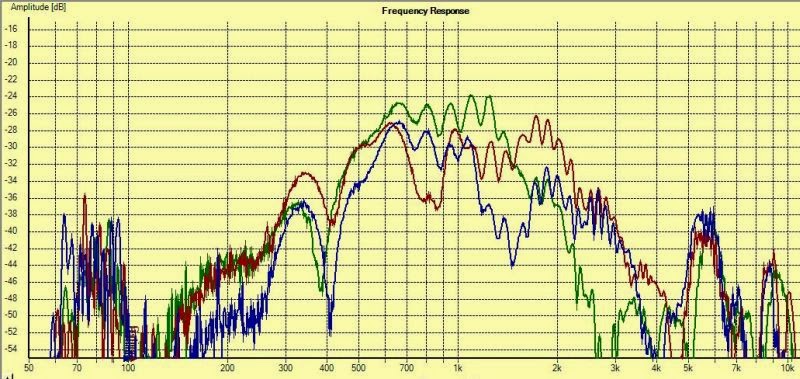
Here's a measurement of the same waveguide, at the same voltage, using the Dayton ND91s in a dipole. (The sealed woofer isn't connected; this is a pure dipole.) I see the following:
1) Directivity is all over the map. It's almost omnipolar, but it varies with frequency. Looks kinda terrible really. And sensitvity is lower than with the Pyle.
2) On the upside, the bandwidth is wider than with the Pyle.
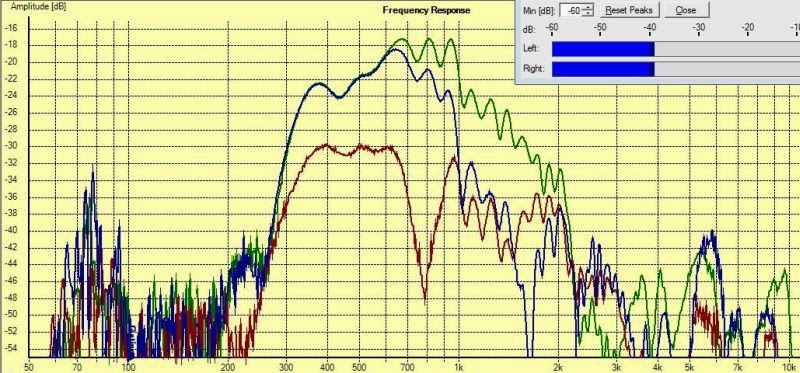
Here's the response as a cardioid. I see the following:
1) Directivity is close to 180 degrees, and rejection to the back is very high. In the two octaves from 300hz to 1200hz the level behind the array is over seven decibels lower than the level in front of the array.
2) Bandwidth is not as wide as the dipole, but sensitivity is higher and it's smoother.
IMHO, this is the best response of the bunch.
I re-did some of these measurements, but outside this time. In these measurements, green is on-axis, blue is 90 degrees off axis, and red is 180 degrees off axis (behind the array.)

Here's a measurement of the waveguide with the Pyle PDMR5 loading it alone. (Only using a single 5" sealed woofer.) I see the following:
1) The directivity narrows at 600hz, as the waveguide isn't large enough to control it
2) The bandwidth is relatively narrow; basically two octaves from 300hz to 1200hz

Here's a measurement of the same waveguide, at the same voltage, using the Dayton ND91s in a dipole. (The sealed woofer isn't connected; this is a pure dipole.) I see the following:
1) Directivity is all over the map. It's almost omnipolar, but it varies with frequency. Looks kinda terrible really. And sensitvity is lower than with the Pyle.
2) On the upside, the bandwidth is wider than with the Pyle.

Here's the response as a cardioid. I see the following:
1) Directivity is close to 180 degrees, and rejection to the back is very high. In the two octaves from 300hz to 1200hz the level behind the array is over seven decibels lower than the level in front of the array.
2) Bandwidth is not as wide as the dipole, but sensitivity is higher and it's smoother.
IMHO, this is the best response of the bunch.
The results are remarkable. It's difficult to describe how good the bass is, because most people simply haven't experienced a subwoofer and room that's engineered to these kinds of standards. In Jon's bus, it's not just about a lot of clean output; it's the impulse response that's so remarkable. The bass notes hit, and then decay into a noise floor that's completely black. It's almost like you're not listening in a room or a car; it's like the walls just aren't there.
Sorry to be late to the party.
Wow. Your remarks clearly mirror my experience. I achieve it with a couple of small cheapo Polk subs in the direct field, just behind my head. That gets half of the way to great. The real magic starts with the addition of electronic cancellers/absorbers similar to Nelson Pass' Shadow. That is when the walls dissolve. The acoustic signature of the small room disappears and leaves whatever room signature is recorded in the music. Symphonic works can be disturbingly real.
- Status
- This old topic is closed. If you want to reopen this topic, contact a moderator using the "Report Post" button.
- Home
- Loudspeakers
- Multi-Way
- I Fought The Law